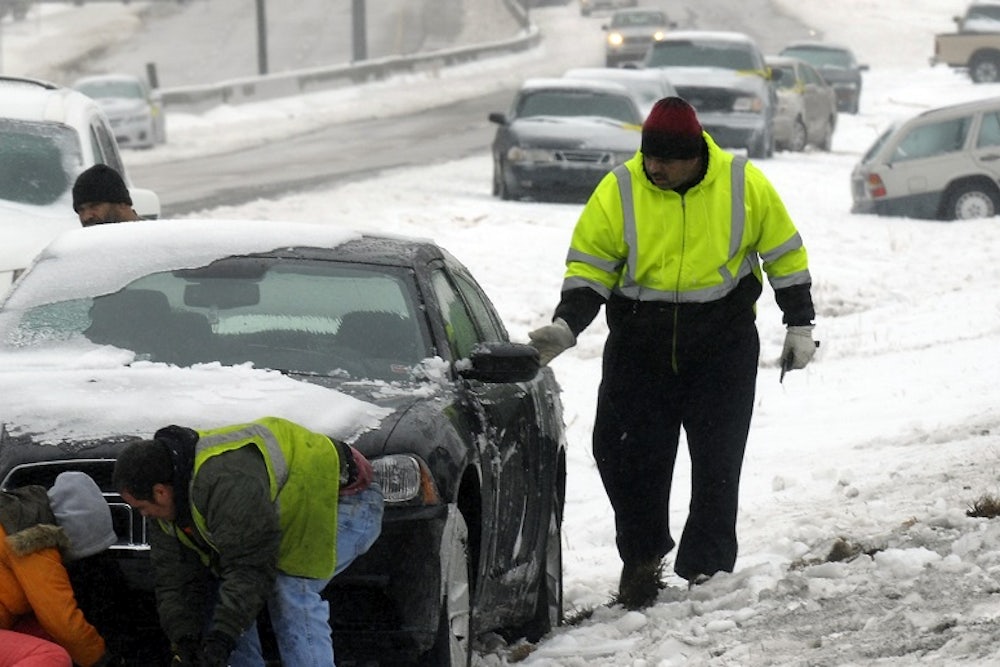The economy contracted at an annualized rate of negative 2.9 percent in the first quarter of this year. In other words, the economy in the first three months of the year actually shrank. The contraction is worse than expected: forecasters were predicting it would be just negative 1.8 percent. And to give you a sense of scale, GDP fell by 8.9 percent in the fourth quarter of 2008, at the depths of the recession. In other words, this is an ugly number.
It’s also not entirely unexpected. This was the Bureau of Economic Analysis’s third revision to the number. Before Wednesday, it already revised it from a positive 0.1 percent to negative 1.0 percent and now, to negative 2.9 percent. Fewer exports, a drawdown in inventories, and reduced consumer spending were the main drivers of this significant negative revision. The first two factors are not surprising. Exports and inventories were both major positive contributors to unexpectedly strong growth in the fourth quarter of 2013. Economists expected a reversion to the mean in both of those categories, as businesses used up backlogged inventory and international consumers smoothed out their consumption of U.S. goods and services over time.
The fall off in consumer spending— technically known as personal consumption expenditures—is what few people expected. When the BEA’s second estimate of GDP found that the economy had contracted at negative 1.0 percent, investors kept calm for two reasons: the nasty winter had slowed economic activity in a couple major sectors (housing, etc.) and consumer spending was still strong. Now, the latter reassurance is gone.
But this may be a case of bad news that’s not so bad—and maybe even good. The reason why consumer spending fell is that health care spending decreased by 1.4 percent in the first quarter. In fact, in the BEA’s second estimate, health care spending contributed 1.01 percent to the growth rate. Under the third estimate, it subtracted 0.16 percent. In other words, health care spending went from a strong contributor to GDP growth to a detractor from it—all in a quarter when millions of Americans gained health insurance.
Former Congressional Budget Office director Peter Orszag was one of the only ones to see this steep drop off in health care spending coming. But even he was surprised by Wednesday’s numbers. “Here’s what’s truly astonishing, which is that in the first quarter of 2014, there were millions more insured people and total spending fell by 1.4 percent on an annualized basis in real terms,” Orszag said. “It’s almost mind-blowing.
“If I had stood up in 2009 and said I think in the beginning of 2014 total health care spending would be falling at 1.4 percent after adding people to the rolls and Medicare would alone be up 0.3 percent nominal and therefore also negative in real terms, I would have been dismissed as a quack,” he added.
If lower health care spending is driving low GDP growth, suddenly the topline number doesn’t look quite as bad. After all, for decades economists have tried to slow the growth in health care spending. There are also other reasons to be optimistic about the economy. Before Wednesday’s GDP numbers, there was a streak of positive economic data: from above average consumer and business confidence to new home sales jumping to a six-year high. We’ve also seen a number of pieces of anecdotal evidence that wage growth could be coming soon. At the same time, Federal Reserve chair Janet Yellen has shown adequate patience so far in not prematurely tightening policy in response to inflation hawks.
“The GDP decline in the first quarter reflects a bad brew of one-off factors. Bad weather, an inventory correction, the expiration of emergency unemployment insurance benefits, and a slip in global growth all conspired to hurt growth at the start of the year,” Mark Zandi, the chief economist at Moody’s, wrote in an email. “Growth in the current quarter is strong as these one-time problems fade away. GDP growth has been about 2% annually since the recovery began 5 years ago, and that has not changed through the first half of this year.”
While these are all welcome developments, it’s also important to remember that, overall, the economy is still underperforming. Five-plus years into the economic recovery, growth should be a lot higher than two percent. And there is much more the federal government could do to improve it. The optimal solution—one that not even Democrats will touch—is another round of fiscal stimulus. We still have a significant hole in aggregate demand—total consumer demand for goods and services. Long ago, the federal government could have used deficit spending to fill that gap, but a premature turn to austerity from the White House and steep Republican opposition instead gave us sequestration, the exact opposite prescription for the economy. Wednesday’s GDP number, while not nearly as worrisome as it initially sounds, is a reminder of the frequent policy failures over the past few years.
